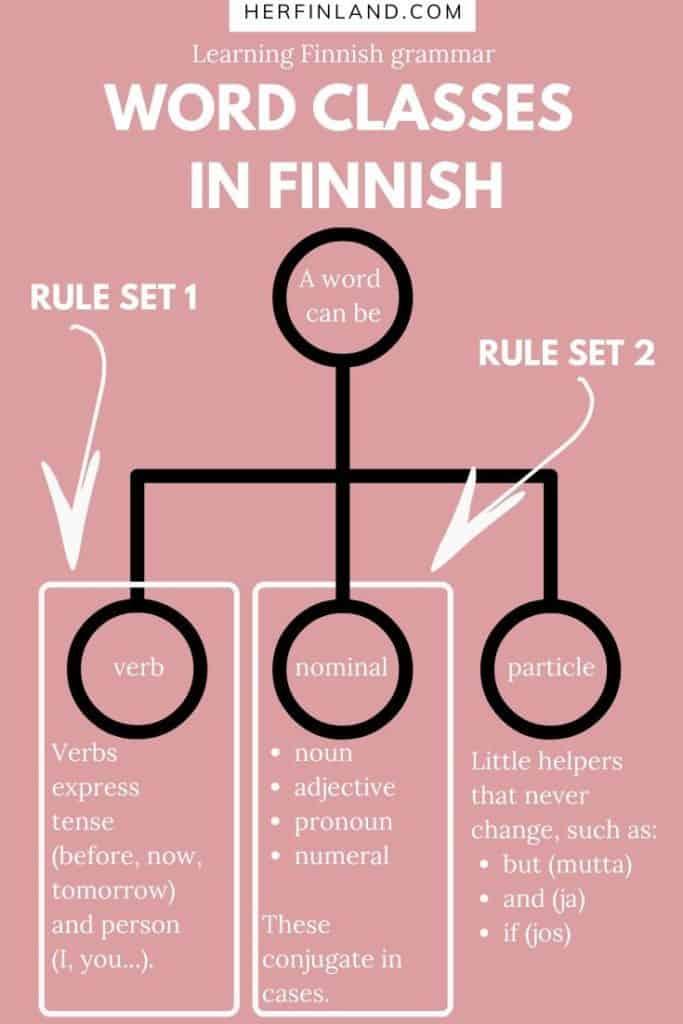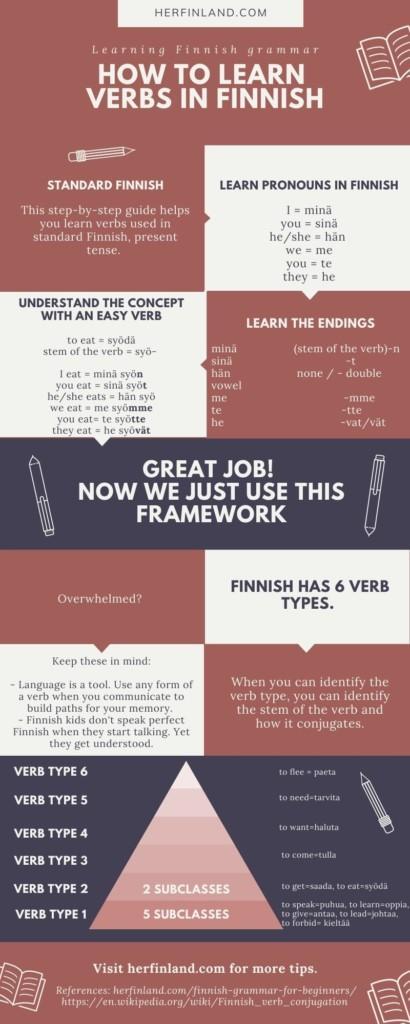I know, Finnish has a reputation.
For example, the US State Department’s Foreign Service Institute lists Finnish among the group of languages considered the most difficult for English speakers.
I get a lot of questions about how long it takes to learn Finnish. I always say it depends. If you focus on learning spoken Finnish, it’s faster to master than standard Finnish because spoken Finnish is shorter and more relaxed (more about how to learn it later in this article).
When it comes to standard Finnish, it might be helpful to know the FSI estimates learning fluent Finnish takes around 1100 hours.
Phew, what a relief! That’s far less than the recommended 10 000 hours of deliberate practice to become a master in any field. So, you just have to start somewhere.
My goal is to help you look at the Finnish language as lovingly as I look at my delicious blueberry pie.
To jump straight into course learning, check out my Conversational Finnish for Beginners Course. If you want a smaller step in the right direction, you can also boost your confidence with my FREE Spark Your Finnish class.
This is a long post so grab your favorite beverage and let’s dive in.
Disclosure: This blog post offers simplified versions of the basic concepts in Finnish grammar. I’m an MSc in Technology by profession and wildly obsessed about showing you that you can learn Finnish.
Table of Contents
- Finnish Grammar for Beginners
- Introduction to the Basics of Finnish Grammar
- Introduction to Verbs in Finnish
- Noun Cases in Finnish
- Common Questions about Finnish Grammar
- How many cases are there in Finnish?
- Do Finns remember the weird grammatical names of all the nominal cases?
- How many types of verbs are there in Finnish?
- How many tenses are there in Finnish?
- What is partitive in Finnish?
- Does the Finnish language have a future tense?
- Does Finnish have gender?
- How long it takes to learn Finnish?
- If a non-Finn speaks broken Finnish, how does it sound?
- Finns always speak English to me. Is my Finnish that bad?
- Learn Spoken Finnish Easily
Finnish Grammar for Beginners
While Finnish isn’t related to the Latin or Germanic language groups, it has many things going for it.
The Finnish alphabet contains only a couple of new letters and words are pronounced as written. Also, Finnish has no articles. That’s why Finns always forget articles in other languages.
It’s the grammar where things can get a bit complicated, but most things are very streamlined. For example, Finnish has no future tense. Finns use the present tense.
Fortunately, even grammar follows a set of rules.
This article will walk you through the basics of Finnish grammar and answer some of the questions that often arise at the beginning of this journey.

Why does Finnish feel like your first attempt to cross-country ski? That’s because Finnish belongs to the Finno-Ugric family of languages. The good news is that Finnish follows the rules, just like skiing tracks.
Introduction to the Basics of Finnish Grammar
The first thing you’ll notice when you start learning Finnish is suffixes added to the end of words. This seems complex at first but, once you learn the rules, things become more manageable.
Finnish doesn’t use many little words or prepositions to link nouns, pronouns, or phrases within sentences.
Instead, Finnish has cases, which correspond to different suffixes added to the end of a word.
Finnish word classes are verbs, nominals and particles.
- Particles stay as they are, no cases here (hurrah!).
- Verbs follow certain rules.
- All nominals (nouns, adjectives, pronouns and numerals) follow another set of rules.
Here’s an infograhic that helps understand the big picture.

Next, let’s look at how to form words with the appropriate suffixes in Finnish in a little more detail.
Introduction to Verbs in Finnish
Conjugation means changing a verb to express tense (before, now, tomorrow) and person (you, she, we, etc.).
In Finnish, verbs are conjugated according to rules that cover six types of stems. Don’t lose your hope yet, I know this may sound scary but hear me out.
It simply means that if the infinitive (the basic form of the word) ends in, for example, a combination of vowels, the changes for conjugating the verb follow one set of rules.
Once you recognize the type of verb you’re dealing with, the changes within the word follow a set of rules.

Noun Cases in Finnish
Instead of many prepositions like at, from, in, with and as, Finnish has noun cases which are formed by adding a suffix at the end of the word.
All nominals use the same logic when it comes to cases. Let’s focus now on nouns because they are the most important when building your language skills in Finnish.
For example, “in the house” translates to talossa, where talo is the basic form of the word “house”, and the suffix -ssa is used in place of “in”.
The word itself may change to make it easier to pronounce. It requires changing vowels (or what is called consonant gradation).
For example, when you want to form the word “flower’s”, the word for “flower” kukka becomes “kukan” in the possessive instead of “kukkan”.
When you want to form the word “feet”, the word for “foot” jalka becomes “jalat” instead of jalkat.
My students tell me that learning the cases and stems is hard. I agree that there are a lot of rules and a lot ot learn. On the other hand, there are hardly any exceptions.
The most popular grammar question I get is “What’s Finnish partititive?”. Here’s my helpful post about how to start learning Finnish partitive.
And you know what? When Finnish kids are learning Finnish, they don’t know the endings and stems of the words either. Yet they are confidently talking Finnish and being understood.
My daughter is now two and she is saying “jalkat” all the time. The correct plural form is jalat as we just learnt.
Little by little she gets some of endings and stems correct and continues to learn. You cannot learn a language if you’re afraid of making mistakes.

Ready to speak finnish?

Join my praised free class and speak Finnish words in 20 minutes!
Common Questions about Finnish Grammar
How many cases are there in Finnish?
There are 15 grammatical cases that can be added to the end of a nominal (nouns, adjectives, pronouns and numerals) to change its meaning. These tend to be the most challenging part of the language for foreigners to grasp. Don’t panic. Now it’s time to use your sisu.
The suffixes play the same role as prepositions do in the English language. All nominals follow the same set of rules.

Do Finns remember the weird grammatical names of all the nominal cases?
I’d say most Finns remember only some of them. We do learn them at school, though.
How many types of verbs are there in Finnish?
There are six verb types in Finnish. As mentioned above, Finnish verbs can be divided into six types based on how the infinitive form of the word (for example, “to speak”) ends.
Type I verbs cover many words ending in two vowels and are divided into subclasses. Type II verbs also have two subclasses.
How many tenses are there in Finnish?
Finnish has four tenses for verbs: the present (nonpast), the past, the perfect, and the past-perfect. They are similar to English, with the exception that the present covers phrases referring to the future, such as “I’m going to…” and “I will…” The past tense in grammar is called “imperfect” for historical reasons, and the past-perfect is called “pluperfect”.
For example:
- Present: I eat/I will eat – Syön
- Imperfect: I ate – Söin
- Perfect: I have eaten – Olen syönyt
- Pluperfect: I had eaten – Olin syönyt
See, there aren’t too many Finnish tenses to learn!
What is partitive in Finnish?
The partitive case can be a bit of a mystery. It is used in Finnish in several different situations and is indicated by the endings -a, -ä, -ta, -tä.
The partitive can refer to, for example:
- an indefinite number of things (ostan maitoa, I buy milk)
- when something is being done (kirjoitan kirjettä, I’m writing a letter)
- in some cases to describe how something is (on mukavaa laulaa, it is nice to sing)
- in greetings (Hyvää joulua!, Merry Christmas!)
- when there are more than one of something (kolme kissaa, three cats)
- in negative existential sentences (ulkona ei ole koiraa, there isn’t a dog outside)
- in negative sentences that would otherwise use the accusative (en nähnyt häntä siellä, I didn’t see him there)
Does the Finnish language have a future tense?
Finnish doesn’t have a future tense. Instead, Finns use the present tense, and the context is what sets apart something happening now (syön keittoa, I eat soup) and some time from now (syön keittoa huomenna, I will eat soup tomorrow).
It’s possible to highlight that you plan to do something in the future by using the word aikoa: aion syödä keittoa huomenna (“It is my intention to eat soup tomorrow”). In spoken Finnish, Finns use the verb mennä: meen uimaan huomenna (I’ll go swimming tomorrow”).
Does Finnish have gender?
All Finnish pronouns are gender-neutral, and grammar lacks gender. In practice, this means Finns don’t use different pronouns to indicate gender (he or she), and the word hän can refer to both males and females.
Some words have masculinity or femininity in them, for example, mother tongue(äidinkieli), fatherland (isänmaa) and, similar to English, some occupations too, such as fireman (palomies).
How long it takes to learn Finnish?
When it comes to standard Finnish, it might be helpful to know the FSI estimates learning fluent Finnish takes around 1100 hours.
Spoken Finnish is shorter and more relaxed than standard Finnish. Try my free Finnish class here!
If Finnish makes you feel like you’re wondering alone in a forest, I’m pretty sure you’re a hidden Finn. Finns love to be in nature.
If a non-Finn speaks broken Finnish, how does it sound?
In my opinion, it sounds cute. You shouldn’t worry about that at all! As I said earlier, when Finnish toddlers are learning Finnish, they don’t know the endings and stems of the words either. Yet they are confidently talking Finnish and being understood.
Finns are always honored when someone is learning Finnish. If you’re not making mistakes when learning Finnish, I would suspect that you’re blocking your progress because most likely you’re capable of using the language more but are limiting yourself within your comfort zone.
FinNISH CONNECTION COLLECTION 🇫🇮

Finland-themed sweaters and accessories made-to-order. 🧡 Worldwide shipping.
Finns always speak English to me. Is my Finnish that bad?
This is nothing personal, I promise. From a local viewpoint, Finnish people are trying to be polite and letting you know that they can speak English.
Don’t fall into this trap. Tell the Finn immediately that you want to learn Finnish. For example, say the following sentence: “Oh, thank you so much for speaking English. I want to learn Finnish, could we speak Finnish? I’ll let you know when I don’t understand.” If you want to say it in easy Finnish, just say. “Puhutaan suomea” with a big smile.
I’m sure that any Finn will do their best to help you as it’s an honor to help you on your Finnish language journey.
Psst… Follow me on Instagram and join my Finnish lesson every Tuesday on Instagram Stories!
Näytä tämä julkaisu Instagramissa.
Learn Spoken Finnish Easily
If you’re curious about learning to speak Finnish, but not so fascinated about learning a lot of grammar, here’s your chance to discover the Finnish language.
Enroll in my free Finnish class for you – Spark Your Finnish.
After taking this class, you’ll know how to say any Finnish word and see why Finnish isn’t impossible, thanks to my secret ingredient. Join our over 18 200 other students.
Feeling tired and discouraged when learning Finnish? Check out these Finnish language memes that will help you learn and laugh at the same time.
Wow, we made it! I’m so proud of you for reading this through. I hope this quick guide to Finnish grammar was helpful.
As I’m always updating my posts to serve you better, I’d love to know: what do you think about the Finnish grammar and learning the Finnish language? Drop me a comment and let me know.
Looking for more information about the Finnish language and culture? Check out these resources:
- Spark Your Finnish and enroll in my Free Finnish Class!
- Best Free and Paid Finnish Language Learning Resources for Beginners
- 50 Funny Finnish Phrases & Words in English the Help You Understand the Finnish Mindset
- 20 Sweet Ways to Say I Love You in Finnish
- Easy Rules to Finnish Small Talk





Vrikson Acosta
Sunday 11th of June 2023
Could you explain what are the 5 subclasses fo verb type 1 and the 2 subclasses fo verb type 2?
Shouldn't the negative particle for the third person in present tense be in accordance to the vowels on the verb? That is, eivat, if the verb doesn't have front vowels, and eivät, if the verb doesn't have back vowels. So the sentence "They do not speak Finnish" should be translated into Finnish as "He eivat puhu suomea", instead of "He eivät puhu suomea", right?
Kiitos paljon!
Marja
Wednesday 5th of October 2022
"It’s the grammar where things can get a bit complicated, but most things are very streamlined. For example, Finnish has no future tense, Finns use the present tense." What do you mean by Finnish not having no future tense? Yes, there is and there still will be... kyllä yhä tulee olemaan!
Varpu
Friday 14th of October 2022
Hei Marja! A great comment. I mean that we cannot the verb into the future tense in Finnish in the way we do it in many other languages. We can still talk about the future, of course, we just do it differently. :)
Anthony
Thursday 28th of October 2021
Moikka! I have a question about the Hän verbs (type 3 verbs some videos call it). When the subject is a person/place 's name (which, in English, would be considered as third person singular as well), do you still write the verbs in the same way as you do with Hän? Kiitos paljon!
Varpu
Wednesday 3rd of November 2021
Hei Anthony! Yes! For example: Helsinki is a big city. Helsinki on iso kaupunki!
Andrew Hope
Friday 3rd of September 2021
Hi Varpu
2nd link in Google for learning Finnish :)
Nice site, I follow you on Insta, so I'm sure to be learning along the way since Finnish is one of the languages I'm most interested in. I enjoy your site. The colour schemes are a bit hard to read on this page sometimes.
Varpu
Wednesday 8th of September 2021
Hei Andrew! Thank you so much for commenting. I'm so grateful for your feedback about the colors. Thank you so much for letting me know!
Stuart Rosenlund
Wednesday 25th of November 2020
Is learning the Finnish alphabet critical in learning the Finnish language? Also, is it better to learn the grammar or expand your vocabulary first?
Varpu
Wednesday 2nd of December 2020
Hei Stuart! Good news: the Finnish alphabet is super straight-forward. You can learn it in my free Finnish class: https://herfinland.teachable.com/p/spark-your-finnish. I would start my Finnish language journey with easy spoken Finnish!